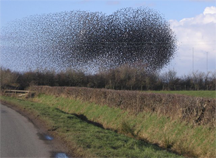
A flock of starlings acting as a swarm. Swarms aren't centrally directed. Each individual bird abides by simple rules of maneuver, from which the behavior of the swarm emerges. So it is with Fear/Anxiety Bias. Each individual in the organization seeks personal safety by reporting only what he or she feels safe to report. A biased view of the state of the organization emerges from the "swarm" of individual choices. Image (cc) Attribution-ShareAlike 2.0 Generic by John Holmes courtesy Wikimedia Commons.
If we rely on reports of workplace process hindrances to enable us to focus resources to resolve obstacles effectively, we're dependent on unbiased reporting. That is, we hope that the stream of reports allows the recipients of those reports to develop an accurate representation of the threat landscape. Unbiased reporting is important because biased reporting can cause the report recipients to allocate resources sub-optimally, which leads to unnecessary costs and delays.
One source of bias in reporting hindrances is inadequate psychological safety. The dual of psychological safety, fear/anxiety, causes reporters to bias their reports — a phenomenon we might call fear/anxiety bias. For example:
ManagerTwo had been a strong advocate of ApproachAlpha, while DeveloperOne had harbored serious doubts about its wisdom. DeveloperOne did express those doubts, though perhaps not as strongly as she could have. Because she had recognized that ManagerTwo was inclined to favor ApproachAlpha, she felt it safest and wisest not to critique ApproachAlpha too strongly. She registered her objections, and then went along with ManagerTwo when he adopted ApproachAlpha.
We might call this scenario the "Too Mild Objection." It's an example of the effects of fear and anxiety, and it follows the path that connects inadequate psychological safety to organizational failure. It's a path we know too well.
But there are other paths, less well known, that are just as dangerous. They're the topic of next week's post. Meanwhile, this post provides a brief review of psychological safety, which is useful for understanding these other patterns that people use to manage the risk of speaking the truth.
A brief review of psychological safety at work
A sense Although feeling psychologically safe
is essentially an individual state,
Fear/Anxiety Bias, as a phenomenon,
emerges at the group levelof psychological safety at work is the belief that the workplace is safe for interpersonal risk taking. [Edmondson 2014] [Frazier 2017] Psychological safety is the perception that the consequences of taking interpersonal risks are acceptable or even welcome. Feeling psychologically safe is essential to learning, because learning entails voluntarily accepting the consequences of potential failure. Edmondson and Lei provide a persuasive summary of the research connecting psychological safety with organizational performance. [Edmondson 2014]
When a sense of psychological safety is absent — when fear and anxiety lead us to feel that we are in a state of psychological risk — we're less likely to engage in behaviors that we feel could lead to unwelcome consequences. We're reluctant to try new things, we don't speak up about issues we recognize as obstacles, and we limit our exposure to risks generally.
Fear/Anxiety Bias is an emergent phenomenon
Although feeling psychologically safe is essentially an individual state, Fear/Anxiety Bias, as a phenomenon, emerges at the group level. That is, when managers arrive at a biased assessment of the state of the organization because of biased reporting due to fear and anxiety, no single individual is the source of the bias. The bias is emergent. Its source is the body of all reporting, rather than any single individual's report (or choice not to report).
For example, in the scenario above, the choice not to report the difficulties encountered in implementing ApproachAlpha is in each case a personal choice. But bias is the result only if all (or most) of the team members elect not to report the problem. Fear and anxiety are personal feelings; but the bias is emergent, emerging from the array of choices the team members make.
Those choices, however, are not made independently. How one team member chooses to mitigate psychological risk affects how others do. For example, if fear and anxiety are deeply rooted in the culture, the familiar adage applies: "Whoever speaks first, speaks last." That is, when one person speaks up, the others remain quiet. The quiet ones rationalize that the report of trouble has been delivered, so there is no need to take on any personal risk. When people know that this pattern is likely in place, no one dares speak first. To the question, then, "Has anyone encountered any hindrances?" the response is stony silence.
In some rare instances, people form a Cabal of Honesty, the members of which all agree to report the truth of the situation. But if management responds by "killing the messengers," one by one, most such cabals collapse quickly. And as long as social memory of the incident persists, future Cabals of Honesty are unlikely to form.
Last words
The connection between psychological safety and fear/anxiety bias is inherently difficult to measure. We can explore psychological safety by sampling individuals; to explore fear/anxiety bias we must examine group behavior. Focusing on measuring the bias alone is little help, because measuring the amount of bias would require comparing the biased reporting to some unbiased standard, which, of course, is unavailable.
What we can measure is the incidence of tactics people use to avoid the risks of speaking the truth about hindrances and obstacles. Next time, I provide a short catalog of these tactics. ![]() Next issue in this series
Next issue in this series ![]() Top
Top ![]() Next Issue
Next Issue
Is every other day a tense, anxious, angry misery as you watch people around you, who couldn't even think their way through a game of Jacks, win at workplace politics and steal the credit and glory for just about everyone's best work including yours? Read 303 Secrets of Workplace Politics, filled with tips and techniques for succeeding in workplace politics. More info
Footnotes
Your comments are welcome
Would you like to see your comments posted here? rbrenaXXxGCwVgbgLZDuRner@ChacDjdMAATPdDNJnrSwoCanyon.comSend me your comments by email, or by Web form.About Point Lookout
 Thank you for reading this article. I hope you enjoyed it and
found it useful, and that you'll consider recommending it to a friend.
Thank you for reading this article. I hope you enjoyed it and
found it useful, and that you'll consider recommending it to a friend.
This article in its entirety was written by a human being. No machine intelligence was involved in any way.
Point Lookout is a free weekly email newsletter. Browse the archive of past issues. Subscribe for free.
Support Point Lookout by joining the Friends of Point Lookout, as an individual or as an organization.
Do you face a complex interpersonal situation? Send it in, anonymously if you like, and I'll give you my two cents.
Related articles
More articles on Workplace Politics:
 Reactance and Micromanagement
Reactance and Micromanagement- When we feel that our freedom at work is threatened, we sometimes experience urges to do what is forbidden,
or to not do what is required. This phenomenon — called reactance — might explain
some of the dynamics of micromanagement.
 Before You Blow the Whistle: I
Before You Blow the Whistle: I- When organizations know that they've done something they shouldn't have, or they haven't done something
they should have, they often try to conceal the bad news. When dealing with whistleblowers, they can
be especially ruthless.
 Grace Under Fire: II
Grace Under Fire: II- When we debate at work, things sometimes turn unpleasant. Out of control, one party might maneuver the
other into losing control. If we have better tools for recognizing these tactics, we're better able
to maintain self-control. Here's Part II of such a toolkit.
 On Reporting Workplace Malpractice
On Reporting Workplace Malpractice- Reporting workplace malpractice can be the right thing to do. And it's often career-dangerous. Here
are some risks to ponder before reporting what you know.
 Narcissistic Behavior at Work: VIII
Narcissistic Behavior at Work: VIII- Narcissistic behavior at work can have roots in attitudes and beliefs. Understanding which attitudes
or beliefs underlie narcissistic behavior can sometimes have predictive value. Among such attitudes
or beliefs are those related to envy.
See also Workplace Politics for more related articles.
Forthcoming issues of Point Lookout
 Coming October 1: On the Risks of Obscuring Ignorance
Coming October 1: On the Risks of Obscuring Ignorance- A common dilemma in knowledge-based organizations: ask for an explanation, or "fake it" until you can somehow figure it out. The choice between admitting your own ignorance or obscuring it can be a difficult one. It has consequences for both the choice-maker and the organization. Available here and by RSS on October 1.
 And on October 8: Responding to Workplace Bullying
And on October 8: Responding to Workplace Bullying- Effective responses to bullying sometimes include "pushback tactics" that can deter perpetrators from further bullying. Because perpetrators use some of these same tactics, some people have difficulty employing them. But the need is real. Pushing back works. Available here and by RSS on October 8.
Coaching services
I offer email and telephone coaching at both corporate and individual rates. Contact Rick for details at rbrenaXXxGCwVgbgLZDuRner@ChacDjdMAATPdDNJnrSwoCanyon.com or (650) 787-6475, or toll-free in the continental US at (866) 378-5470.
Get the ebook!
Past issues of Point Lookout are available in six ebooks:
- Get 2001-2 in Geese Don't Land on Twigs (PDF, )
- Get 2003-4 in Why Dogs Wag (PDF, )
- Get 2005-6 in Loopy Things We Do (PDF, )
- Get 2007-8 in Things We Believe That Maybe Aren't So True (PDF, )
- Get 2009-10 in The Questions Not Asked (PDF, )
- Get all of the first twelve years (2001-2012) in The Collected Issues of Point Lookout (PDF, )
Are you a writer, editor or publisher on deadline? Are you looking for an article that will get people talking and get compliments flying your way? You can have 500-1000 words in your inbox in one hour. License any article from this Web site. More info
Follow Rick
Recommend this issue to a friend
Send an email message to a friend
rbrenaXXxGCwVgbgLZDuRner@ChacDjdMAATPdDNJnrSwoCanyon.comSend a message to Rick
![]() A Tip A Day feed
A Tip A Day feed
![]() Point Lookout weekly feed
Point Lookout weekly feed
 My blog, Technical Debt for Policymakers, offers
resources, insights, and conversations of interest to policymakers who are concerned with managing
technical debt within their organizations. Get the millstone of technical debt off the neck of your
organization!
My blog, Technical Debt for Policymakers, offers
resources, insights, and conversations of interest to policymakers who are concerned with managing
technical debt within their organizations. Get the millstone of technical debt off the neck of your
organization!